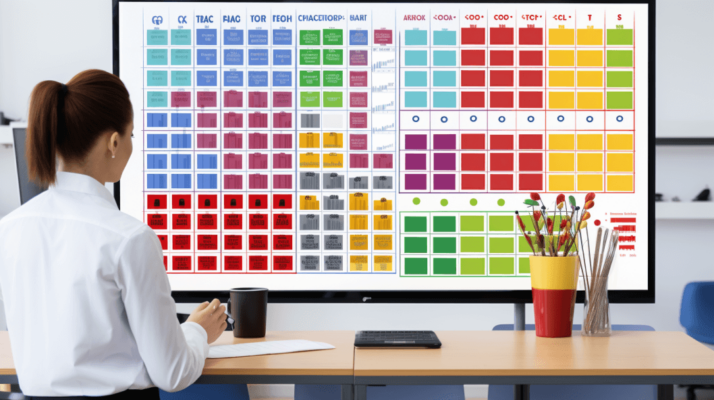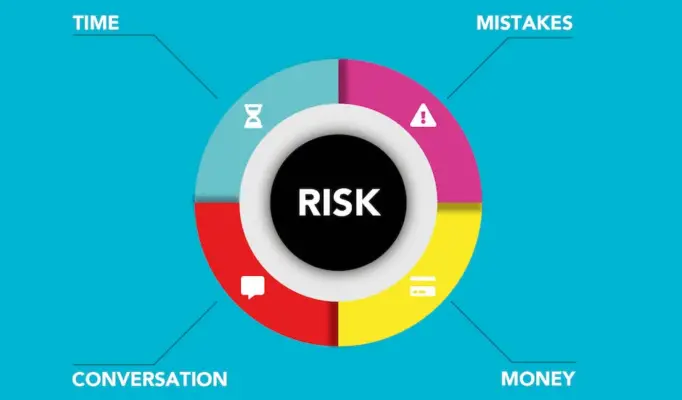A risk matrix evaluates and ranks risks by their likelihood and impact, aiding in decision-making and risk management. It offers a structured approach to identify, evaluate, and respond to risks effectively.
By representing risk severity against likelihood, it helps enhance risk assessment, supports prioritization, and assists in developing mitigation strategies.
However, challenges like subjective categorization and data accuracy need consideration.

Customizing a risk matrix to organization-specific criteria and integrating control measures can optimize risk management. Using a risk matrix can prove valuable for numerous organizations seeking to manage risks efficiently and safeguard their interests. Further insights into using this tool await.
Key Takeaways
- Risk matrix evaluates risks by probability and impact.
- It aids in decision-making and risk management.
- Helps in identifying, prioritizing, and mitigating risks.
- Enhances risk assessment processes and decision-making.
- Customization and integration improve risk handling and management.
Definition of a Risk Matrix
A risk matrix serves to evaluate and rank risks based on their probability and impact, aiding in decision-making and risk management. Its components include likelihood, consequences, and risk levels, helping organizations understand and address potential threats.
The importance of this lies in its ability to provide a structured approach for identifying, evaluating, and responding to risks effectively.
Purpose of Risk Matrix
The definition of a risk matrix lies in its ability to visually represent the severity of risks in relation to their likelihood of occurrence, facilitating informed decision-making and risk management processes.
This visual tool serves the purpose of enhancing risk assessment by categorizing risks based on their impact and probability.
By using it, organizations can effectively identify risks, prioritize them, and develop mitigation strategies to address potential threats.
The matrix simplifies complex financial risk and data, leading to more efficient risk management practices, improved communication regarding risks, and better resource allocation for mitigation efforts.
Ultimately, the primary goal of it is to help businesses stay proactive in managing risks and making informed decisions to safeguard their interests and ensure long-term success.
Components of Risk Matrix
Key elements comprising a risk matrix include a 5×5 grid showcasing likelihood and severity along the axes for evaluating and categorizing risks based on their impact and probability. Within this risk matrix categories, risk ratings are determined by the intersection of these two factors, providing a clear indication of risk level.
The risk assessment matrix template aids in visualizing risk impact, probability, and severity, essential for effective risk management planning.
By incorporating risk analysis into a structured matrix, organizations can prioritize risks, allocate resources efficiently, and develop mitigation strategies tailored to each risk’s specific characteristics.
Understanding the components of a risk matrix enables businesses to proactively manage potential threats, enhancing overall resilience and decision-making processes.
Importance of Risk Matrix
An indispensable tool for organizations seeking to proactively manage risks and enhance decision-making processes is the risk matrix.
This visual tool categorizes potential risks based on their likelihood and impact, enabling proactive risk management and the development of targeted strategies to mitigate high risk occurring at-risk events.
By prioritizing risks into severity levels, the matrix facilitates the identification of key areas needing attention and helps prevent value losses, ultimately contributing to business continuity.
Implementing a risk matrix involves steps such as identifying risks, evaluating likelihood and impact external risk, and regularly updating assessments for effective risk management.
Utilizing a matrix can streamline decision-making processes and enhance overall resilience, making it a crucial component for organizations looking to safeguard their interests.
Application of Risk Matrix
Moving seamlessly from elaborating on the significance of utilizing a matrix, it is essential to comprehend the practical application of this invaluable tool in evaluating and prioritizing operational risks from within organizations.
A matrix serves as a visual tool that assesses the likelihood and impact of risks, aiding in decision-making processes.
It categorizes risks based on severity and probability, facilitating the development of targeted mitigation strategies.
By providing a snapshot of the threat landscape, the risk matrix enables organizations to prioritize actions effectively.
Utilizing a matrix is vital for understanding, managing, and proactively addressing potential risks, ultimately contributing to effective risk management practices.
- Helps prioritize risks based on severity and probability
- Aids in developing targeted mitigation strategies
- Provides a snapshot of the threat landscape
- Facilitates effective decision-making processes
- Vital for understanding and managing potential risks
Benefits of Using a Risk Matrix
Utilizing a risk matrix offers several key benefits to organizations. It aids in prioritizing risks effectively by categorizing them based on impact and likelihood, helping to focus on the most critical issues first.
Additionally, the visual representation of potential threats in a matrix enhances decision-making processes by providing a clear overview of risks and aiding in the development of targeted risk mitigation strategies.
Prioritizing Risks Effectively
Effectively prioritizing risks plays a pivotal role in bolstering an organization’s resilience and ensuring proactive risk management practices.
Utilizing a matrix can assist in this process by evaluating risks based on their impact and likelihood, enabling targeted strategies for managing high-risk events.
The visual representation provided by the matrix aids in decision-making by highlighting the severity of risks, helping prevent value losses, and maintaining business continuity.
Professionals can swiftly grasp the threat landscape and make informed decisions when using a risk matrix, allowing for a proactive approach to addressing potential challenges.
By prioritizing risks effectively, businesses can enhance their risk management efforts and make informed decisions that contribute to their overall success and resilience.
- Evaluate risks based on impact and likelihood
- Develop targeted strategies for high-risk events
- Visual representation aids decision-making
- Prevent value losses and ensure business continuity
- Grasp threat landscape for informed decisions
Enhancing Decision-Making Processes
Enhancing decision-making processes through the utilization of a risk matrix enables organizations to visually assess and prioritize risks based on their impact and likelihood in a structured manner.
By categorizing risks into a matrix format, decision-makers can efficiently evaluate the severity and probability of each risk, aiding in the prioritization of mitigation strategies.
This structured approach provides a clear overview of potential risks, facilitating quick and informed decision-making processes. Identifying critical risks through the matrix allows organizations to focus on immediate attention and proactive risk management.
The risk matrix streamlines the decision-making process by categorizing risks based on severity and likelihood, ensuring that mitigation strategies are effective and targeted.
| Likelihood | Impact |
|---|---|
| High | High |
| Low | High |
| High | Low |
| Low | Low |
Visualizing Potential Threats
Visualizing potential threats through a risk matrix provides a clear and structured representation of the severity and likelihood of risks for effective decision-making. Utilizing a risk matrix template can help in evaluating identified risks, whether they are operational risks or project risks.
This visual representation aids in determining risk likelihood and categorizing risks based on their severity.
The benefits of using a matrix include:
- Prioritizing high risks that demand immediate attention.
- Simplifying complex data for efficient risk evaluations.
- Enhancing communication of specific risks to stakeholders.
- Assisting in grouping project event outcomes for targeted mitigation strategies.
- Facilitating the assignment of risk ratings within risk evaluation matrices, distinguishing between low and high risks effectively.
Streamlining Risk Management
In addition, utilizing a risk matrix can greatly streamline risk management processes by providing a structured framework for evaluating and prioritizing risks based on their impact and likelihood.
This visual tool simplifies the task of managing risks by categorizing them according to severity and probability, enabling organizations to focus on high-priority risks effectively.
By using a matrix, businesses can develop mitigation strategies, prioritize actions, and communicate risks clearly. It facilitates informed decision-making by identifying potential threats and addressing them promptly.
Furthermore, the matrix serves as a foundation for detailed risk analysis, helping organizations maintain a proactive approach to risk management.

How to Create a Risk Matrix
When developing a risk matrix, the key points to keep in mind are:
- Identifying risk factors
- Evaluating their impact and likelihood
- Determining the corresponding risk levels
By acknowledging potential risks, analyzing their significance, and categorizing them accordingly, organizations can effectively manage and prioritize their response strategies.
This structured approach aids in creating a thorough risk management plan that focuses on addressing the most critical threats first.
Identify Risk Factors
To create a matrix effectively for project management, start by identifying potential risks through a thorough list of factors that could negatively impact your project or business.
- List all possible risk factors that could affect your project or business operations.
- Evaluate each risk factor based on its likelihood of occurrence and impact on the organization.
- Use this evaluation to plot the risks on a risk matrix with likelihood and impact axes.
- Assign severity levels to risks according to their position on the matrix, focusing on high-risk events.
- Develop targeted mitigation strategies and allocate resources efficiently based on the identified risks to enhance risk management efforts.
Assess Impact and Likelihood
After identifying potential risks through an exhaustive list of factors that could negatively impact your project or business operations, the next step in creating a risk matrix is to evaluate impact and likelihood.
Evaluating impact involves gauging the severity of risks, ranging from negligible damage to catastrophic losses, while likelihood entails moderate risks and determining the probability of their occurrence, varying from highly likely to highly unlikely events.
This evaluation helps quantify risks by plotting them on a chart based on impact and likelihood, providing a visual representation to prioritize risks and develop mitigation strategies effectively.
By analyzing impact, risk probability and likelihood, organizations can proactively manage risks and make informed decisions to safeguard their operations.
This structured approach enables businesses to address threats systematically and enhance their resilience.
Determine Risk Levels
Creating a matrix involves systematically evaluating the likelihood and impact of potential risks to determine their levels within a predefined scale.
- The risk matrix helps prioritize risks by categorizing them based on their likelihood and impact.
- It provides a visual representation of the severity of risks to aid in decision-making processes.
- Evaluating risks with a matrix involves plotting them on a chart or table to understand their potential consequences.
- The matrix assists in developing effective risk mitigation strategies to address identified risks.
- Utilizing a matrix streamlines the process of evaluating risks and enhances risk management practices within projects or organizations.
Potential Challenges of Using a Risk Matrix
When utilizing a risk matrix, organizations may encounter challenges related to compliance risk by:
- Implementation hurdles
- Concerns about data accuracy
- Risks of misinterpretation
These potential obstacles can hinder the effectiveness of the risk assessment process and compromise the decision-making based on the risk rating matrix.
Businesses need to address these challenges proactively to guarantee the risk matrix serves its purpose of enhancing risk management practices.

Implementation Hurdles
In the domain of risk management, overcoming the implementation hurdles associated with using a matrix is essential to ensuring effective decision-making and risk mitigation strategies.
To address these challenges effectively, organizations must navigate through various obstacles, such as:
- Subjective risk categorization leads to unreliable decision-making.
- Timeframes for risks are often not considered, potentially overlooking critical aspects.
- Oversimplification of risks can impact risk assessment accuracy by ignoring their dynamic nature.
- Incorrect risk categorization may result in ineffective risk management strategies.
- Bias in risk assessment introduces unreliability in guiding risk mitigation efforts.
Data Accuracy Concerns
Exploring the domain of risk management requires a sharp awareness of potential challenges. One prominent concern lies in the context of data accuracy when using a risk matrix.
Data accuracy concerns stem from the subjectivity of risk assessment criteria, which can lead to an oversimplification of risks, resulting in inaccurate categorization and decision-making. Inaccurate data inputs or outdated information further exacerbate this issue, compromising the effectiveness of the risk matrix.
Variances in risk perception among team members also play a role in impacting the accuracy of risk assessments within the matrix.
To address these challenges, continuous monitoring and validation of data inputs are crucial to maintain the reliability and relevance of the risk matrix in guiding strategic decisions and risk mitigation efforts.
Misinterpretation Risks
Subjective categorization of risks in a risk matrix can introduce misinterpretation risks that hinder effective decision-making processes. When utilizing a risk matrix, several potential challenges may arise:
- Timeframes for risks are often not considered, impacting risk assessment accuracy.
- Oversimplification of risks can lead to overlooking their complexity and potential impact.
- Subjectivity in risk assessment may render the risk matrix unreliable for guiding actions and strategies.
- Incorrectly assessed risks can result in ineffective decision-making processes.
- The complexity of risks may not be adequately captured, affecting the overall reliability of the risk matrix.
These misinterpretation risks highlight the importance of a thorough and objective approach to risk assessment to guarantee the efficacy of risk management strategies.
Considerations Before Using a Risk Matrix
Before implementing a risk matrix, it is important to assess the complexity and diversity of risks your organization encounters and evaluate your team’s capabilities in utilizing this tool effectively.
Additionally, aligning the risk matrix with your organization’s strategic risk and management objectives, culture, and decision-making processes is essential for successful implementation.
Considering these factors will help determine the suitability and potential benefits of integrating a risk matrix into your risk management strategy.
Risk Matrix Benefits
Utilizing a risk matrix offers a structured approach for organizations to assess and prioritize risks effectively to enhance decision-making processes and strengthen risk management practices.
- Risk matrices help in identifying, prioritizing, and managing risks effectively.
- They provide a visual representation of the likelihood and impact of risks, aiding decision-making processes.
- Using a risk matrix can lead to better risk assessment, planning, and mitigation strategies.
- Prioritizing risks with a risk matrix allows for targeted risk management efforts and resource allocation.
- Risk matrices help in communicating risk information clearly to stakeholders and team members.
Implementation Tips
When considering the implementation of a risk matrix, it is crucial to evaluate the organization’s risk management maturity level.
Assess the complexity of the project or business to determine the necessity of a risk matrix.
Engage stakeholders to secure their support for using a risk matrix in the risk assessment stage.
Customize the risk matrix template to align with the specific characteristics and needs of the organization or project.
Provide training to team members on how to effectively utilize and interpret the risk matrix for decision-making.
Define clear risk criteria, categories, and levels within the risk matrix to facilitate the identification of intersecting factors and early warning signs.
Incorporate control measures into the risk matrix to enhance risk management processes.
Frequently Asked Questions
What Is a Risk Matrix and What Is It Used For?
A risk matrix is a strategic tool utilized to evaluate and prioritize risks based on their impact and probability.
This visual representation aids in identifying threats, formulating mitigation strategies, and enhancing decision-making processes for organizations.
What Are the Pros and Cons of Risk Matrix?
The pros of using a risk matrix include visual representation of risks, effective prioritization for mitigation planning, simplification of complex data for informed decisions, prompt identification of threats, and structured project risk and management for project success.
Cons may involve oversimplification and subjective risk assessment.
What Is the Use of Risk Control Matrix?
The use of a risk control matrix lies in documenting internal controls to manage risks effectively. It outlines key controls, control objectives, and activities to mitigate risks, aiding in evaluating control effectiveness and ensuring efficient risk management within organizations.
Is a Risk Matrix Required?
A risk matrix is not obligatory but highly recommended for organizations aiming to enhance risk management.
It aids in visualizing and prioritizing risks, facilitating informed decision-making and effective mitigation strategies. Utilizing a risk matrix can greatly enhance resilience, project planning and success.

Conclusion
The utilization of a risk matrix is a valuable tool in risk management, enabling organizations to systematically assess and prioritize potential risks based on their probability and impact.
By incorporating a risk matrix into strategic decision-making processes, businesses can enhance their ability to proactively mitigate threats and navigate uncertainties with informed precision.
The structured approach offered by a risk matrix empowers organizations to strengthen their risk management framework, thereby fostering resilience and ensuring sustained operational success.

Chris Ekai is a Risk Management expert with over 10 years of experience in the field. He has a Master’s(MSc) degree in Risk Management from University of Portsmouth and is a CPA and Finance professional. He currently works as a Content Manager at Risk Publishing, writing about Enterprise Risk Management, Business Continuity Management and Project Management.

